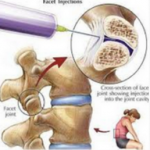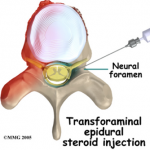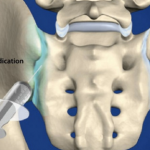Spinal Injection
- Home
- Non-Surgical Procedures
- Private: Chiropractic
- Services
- Spinal Injection
Spinal Injection
Epidural injection

An epidural spinal injection is a non-surgical treatment option that may provide either short- or long-term relief of radiating back pain.
When spinal nerves become irritated or inflamed due to a degenerative condition in the spine that is causing nerve compression, such as a herniated disc or spinal stenosis, the result may be severe acute or chronic back pain, as well as pain, numbness and muscle weakness that extends elsewhere into the body, such as the hips, buttocks or legs.
What Is An Epidural Spinal Injection?
What Is An Epidural Spinal Injection?
An epidural spinal injection involves delivering anti-inflammatory medication – typically a steroid combined with an anesthetic – directly into the area around the irritated spinal nerves that are causing the pain. This area is called the epidural space, and it surrounds the sheath-like protective membrane – ordura – that covers the spinal nerves and nerve roots. Steroids reduce nerve irritation by inhibiting production of the proteins that cause inflammation; the anesthetic blocks nerve conduction in the area where it’s applied, numbing the sensation of pain.
Why Do I Need This Procedure?
Why Do I Need This Procedure?
An epidural spinal injection may be done either for diagnostic or therapeutic reasons:
By injecting medication around a specific nerve root, your doctor can determine if that particular nerve root is the cause of the problem.
long- or short-term relief, anywhere from a week to several months. In some instances, an epidural spinal injection may break the cycle of inflammation and provide permanent relief.
It’s important to note, however, that an epidural spinal injection is typically not considered a “cure” for symptoms associated with spinal compression. Rather, it’s a treatment “tool” that a doctor can use to help ease a patient’s pain and discomfort as the underlying cause of the problem is being addressed through chiropractic treatment like Cox decompression manipulation, or while the patient is considering his or her surgical treatment options.
How Is An Epidural Spinal Injection Administered?
How Is An Epidural Spinal Injection Administered?
Delivering a mild sedative via an intravenous (IV) drip for relaxation (if desired);
Wiping the skin with an antiseptic to clean the area where the epidural needle will be inserted;
Injecting a local anesthetic to numb the injection site;
Directing a small needle using fluoroscopy (a type of x-ray guidance that allows your doctor to monitor the placement of the needle) into the epidural space;
Injecting a small amount of contrast dye to confirm that the needle is placed properly, and that the medication spreads to the area where it’s needed;
Injecting the steroid/anesthetic medication into the epidural space; and
Removing the needle from the epidural space, wiping the injection site with an antiseptic and covering it with a bandage.
The procedure typically takes 15-30 minutes. After the procedure, you’ll be monitored for about 30-60 minutes in the recovery room.
How Long Will It Take Me To Recover?
How Long Will It Take Me To Recover?
After your injection, you may experience some numbness in your arms or legs. This is a temporary side effect associated with the anesthetic component of the injection, and it typically subsides within 1 to 8 hours. Your pain also may increase over the following 24-48 hours; it generally takes 24-72 hours for the pain-relieving benefits of a spinal epidural injection to take effect.
If your injection resolves your pain for a short period of time, you may be interested in another injection, steroid injections given within a certain period of time – three per year is a common guideline. Injection helps to relieve the pain, at least temporarily, it may indicate that surgery will be successful in helping to obtain a permanent solution for the pain.
Are There Any Potential Risks Or Complications?
Are There Any Potential Risks Or Complications?
As with any procedure, there are always certain risks involved with epidural steroid injections. Potential complications may include:
Bleeding or infection at the injection site
Pain during or after injection
Post-injection headache
Reaction to injection medication
Nerve injury, including spinal cord injury and quadriplegia
Bladder dysfunction
Fluid retention
Respiratory arrest
Epidural hematoma (a collection of blood outside a blood vessel caused by a leak or injury)
Spinal cord infarction (occurs when one of the three major arteries that supply blood – and therefore oxygen – to the spinal cord is blocked)
Complications are not a common occurrence; however, because they are potentially much more severe in the cervical spine than in the lumbar spine (low back), many physicians recommend oral steroids instead of cervical epidural spinal injections because of these risks.
Additional risk factors to consider before having an epidural spinal injection include:
If you regularly take platelet-inhibiting drugs such as aspirin or NSAIDS (non-steroidal anti-inflammatory drugs), you may be at increased risk for bleeding.
If you have a serious or active infection, steroids can lower your body’s resistance to and ability to fight it.
If you are hypersensitive to or are allergic to certain medications, you may have a negative reaction to the drugs used in the injection. Please provide your doctor with a list of your allergies and any other medications you are taking.
If you are ill or have a chronic medical condition, please discuss the risks of a cervical epidural spinal injection specific to your condition with your doctor. Patients with diabetes, for example, may experience an increase in blood sugar after an injection. Patients with congestive heart failure, renal failure, hypertension or significant cardiac disease may develop problems due to the effects of fluid retention several days after an injection.
If you are pregnant, inform your doctor. Fluoroscopic x-rays pose great risk to a fetus at all stages of development.
Facet Joint Injection
A facet joint injection, or facet block, is a non-surgical procedure in which a combination anesthetic/steroid is delivered directly into a facet joint in the spine that may be causing back or neck pain. The purpose of the anesthetic is to ease the pain; the steroid to relieve inflammation. The effects of the injection may be temporary or permanent, and the procedure also may be used as a diagnostic tool to determine whether the facet joint is the cause of the pain.

What Is A Facet Joint Injection?
What Is A Facet Joint Injection?
Facet joints connect the vertebrae, and provide for the stability and flexibility of the spine. There are two facet joints between each pair of vertebrae, one on each side. Facet joints link each vertebra to those directly above and below it, and allow the vertebral bodies to rotate with respect to each other. Cartilage in the joints allows for smooth movement where vertebral bones meet, and each is lined with a thin membrane called the synovium, which produces synovial fluid for lubrication.
If the facet joints and the tissues around them become inflamed and swollen, these irritated structures can compress one or more spinal nerve roots. The result may be localized and/or radiating pain and other symptoms, such as numbness and muscle weakness.
A facet joint injection, or facet block, is a non-surgical procedure in which a combination anesthetic/steroid is delivered directly into a facet joint in the spine that may be causing back or neck pain. The purpose of the anesthetic is to ease the pain; the steroid to relieve inflammation. The effects of the injection may be temporary or permanent, and the procedure also may be used as a diagnostic tool to determine whether the facet joint is the cause of the pain.
Why Do I Need This Procedure?
Why Do I Need This Procedure?
There are a variety of spinal conditions that may cause pain and irritation of the facet joints. They include:
Facet joint syndrome
Spinal stenosis
Spondylolysis/spondylolisthesis
Disc herniation
A facet injection is typically recommended for patients with radiating pain, and whose symptoms have not responded to other conservative therapies, such as medication, rest, exercise/activity modification, physical therapy or bracing.
How Is A Facet Joint Injection Administered?
How Is A Facet Joint Injection Administered?
During a facet joint injection, the anesthetic/steroid solution is delivered via a very thin needle, guided by fluoroscopy (a specialized X-ray camera), into the capsule that surrounds the facet joint or in the tissue around the joint capsule. This is different from an epidural spinal injection, in which the injection is placed in the epidural space of the spinal cord, located between the dura (the protective membrane that surrounds the spinal cord and nerves) and the bone of the vertebral canal.
Are There Any Potential Risks Or Complications?
Are There Any Potential Risks Or Complications?
As with any spinal procedure, there is some risk involved. Potential side effects of a facet injection may include:
Pain
Infection
Bleeding
Worsening of symptoms
Spinal, epidural block
Adverse effects (usually temporary) related to the cortisone/steroid component of the injection may include:
Weight gain
Increase in blood sugar
Water retention
Facial flushing
Insomnia
Transforaminal Injection

A transforaminal injection is an injection of long acting steroid into the opening at the side of the spine where a nerve roots exits. This opening is known as a foramen. There is a small sleeve of the epidural space that extends out over the nerve root for a short distance. This epidural root sleeve is just outside the spinal canal. Sometimes these injections are referred to as root sleeve blocks, root blocks or transforaminal epidural blocks.
Sacroiliac Injection

A sacroiliac injection is an injection of a steroid or other medication into a sacroiliac joint. The sacroiliac joints are located on either side or the sacrum or tailbone. They connect the tailbone to the pelvis.
Not recommend for spinal injection
Patient has neurological deficit, like foot drop or cauda equina syndrome from a lumbar herniated disc, surgery might be a better option to free the spinal cord or nerve to allow for better recovery
 Book an Appointment
Book an Appointment


